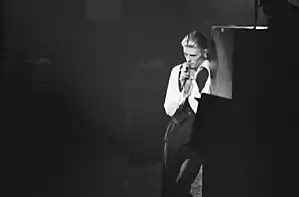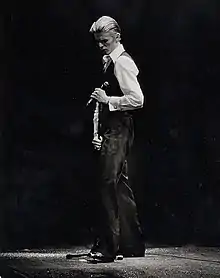The Thin White Duke
The Thin White Duke was the persona and character of English musician David Bowie during 1975 and 1976. He is primarily identified with Bowie's 1976 album Station to Station and is mentioned by name in the title track, although Bowie had first begun to adopt the "Duke" persona during the preceding Young Americans tour and promotion in 1975. The persona's look and character are somewhat based on Thomas Jerome Newton, the eponymous humanoid alien played by Bowie in the 1976 film The Man Who Fell to Earth.[1]
| The Thin White Duke | |
|---|---|
 David Bowie performing as the Thin White Duke live in Toronto, February 1976 | |
| First appearance | 1975 |
| Last appearance | 1976 |
| Created by | David Bowie |
| Portrayed by | David Bowie |
| In-universe information | |
| Occupation | aristocrat, cabaret performer |
The Thin White Duke was a controversial figure due to ostensibly pro-fascist statements made by Bowie in press interviews during this period. Soon after making the comments, Bowie claimed that they were "theatrical" remarks made in character and did not reflect his actual views. In later years, he blamed his erratic behaviour during his mid-1970s Duke era on an "astronomical" use of hard drugs (particularly cocaine) while living in Los Angeles.
Bowie left California for Europe in late 1976 to improve his mental and physical well-being. He settled in West Berlin in early 1977, at which point he quietly retired the Thin White Duke persona.
Development

David Bowie, who had experience performing in experimental theatre before becoming famous as a musician, began adopting different performing personae in the early 1970s, most notably the glam alien Ziggy Stardust. He famously retired Ziggy in 1973 and adopted the dystopian Halloween Jack persona for his Diamond Dogs album and most of the following tour.
An early version of the Thin White Duke character began to appear in late 1974 during the "Philly Soul" leg of the Diamond Dogs tour. During this "plastic soul" lead-up to his Young Americans album, Bowie's hair was still orange, but it was cut shorter, and his stage costumes moderated from colorful glam outfits to more conventional dress clothes. The Thin White Duke was mentioned by name in the title track of Bowie's next album, Station to Station, and he appeared in that persona during the following Isolar – 1976 Tour.
Characteristics
At first glance, the Thin White Duke appeared more conventional than Bowie's previously flamboyant glam incarnations. Sporting well-groomed blonde hair and wearing a simple, cabaret-style wardrobe consisting of a white shirt, black trousers, and a waistcoat, the Duke was a hollow man who sang songs of romance with an agonised intensity while feeling nothing, "dry ice masquerading as fire".[2] The persona has been described as "a mad aristocrat",[2] "an amoral zombie",[3] and "an emotionless Aryan superman".[4] Bowie himself described the character as "A very Aryan, fascist type; a would-be romantic with absolutely no emotion at all but who spouted a lot of neo-romance."[5]
Controversy
The Thin White Duke was a controversial figure. While being interviewed in the persona in 1975 and 1976, Bowie made statements about Adolf Hitler and Nazi Germany that some interpreted as expressing sympathy for fascism or even promoting fascism.[6] The controversy deepened in May 1976 when, while acknowledging a group of fans outside of London Victoria station, he was photographed making what some alleged to be a Nazi salute. Bowie denied this, saying that he was simply waving and the photographer captured his image mid-wave.[7]
As early as 1976, Bowie began disavowing his allegedly pro-fascist comments and said that he was misunderstood. In an interview that year in the Daily Express, he explained that while performing in his various characters, "I'm Pierrot. I'm Everyman. What I'm doing is theatre, and only theatre... What you see on stage isn't sinister. It's pure clown. I'm using myself as a canvas and trying to paint the truth of our time on it. The white face, the baggy pants – they're Pierrot, the eternal clown putting over the great sadness."[8] In 1977 (after retiring the Duke), Bowie stated that "I have made my two or three glib, theatrical observations on English society and the only thing I can now counter with is to state that I am not a fascist".[9]
In later years, Bowie called the mid-1970s "the darkest days of my life" due to "astronomical" usage of cocaine and amphetamines.[10] For much of 1976, he was obsessed with Satanic symbols, remained awake for days at a time, and lived on a diet of red peppers, milk, and hard drugs.[1] In subsequent interviews, he blamed his erratic behavior and fascination with Nazi Germany and the occult during his Thin White Duke period on drug-induced paranoia and depression, and claimed that his mental state was such that he could not remember the late-1975 recording sessions for Station to Station.[11] "It was a dangerous period for me," he explained. "I was at the end of my tether physically and emotionally and had serious doubts about my sanity." [12] Eventually, he began to see the Thin White Duke as "a nasty character indeed",[13] and later, "an ogre".[14]
Aftermath
In an attempt to salvage his mental and physical health, Bowie left California's drug-fueled social scene for Europe in late 1976, staying in Geneva, Switzerland for a time before joining his friend Iggy Pop in West Berlin in early 1977. Though he did not publicly retire the Thin White Duke as he had Ziggy Stardust, Bowie did not appear in the persona after settling in Europe.
Bowie lived in West Berlin for almost two years, during which time he moved on both musically and personally with his "Berlin Trilogy" albums (Low, "Heroes", and Lodger) in collaboration with Brian Eno and Tony Visconti. He also produced Pop's albums The Idiot and Lust for Life .[15]
See also
References
- "David Bowie – the inside story of The Man Who Fell To Earth | Page 6 of 7". UNCUT. 2 April 2015. Archived from the original on 21 July 2020. Retrieved 21 July 2020.
- Carr, Roy; Murray, Charles Shaar (1981). Bowie: An Illustrated Record. New York: Avon. pp. 78–80. ISBN 0-380-77966-8.
- Buckley, David (2000) [First published 1999]. Strange Fascination – David Bowie: The Definitive Story (2nd ed.). London: Virgin. p. 58. ISBN 0-7535-0457-X.
- Pegg, Nicholas (2004) [2000]. The Complete David Bowie. London: Reynolds & Hearn. pp. 297–300. ISBN 1-903111-73-0.
- Doggett, Peter (2011). The Man Who Sold The World: David Bowie And The 1970s.
- Borschel-Dan, Amanda (11 January 2016). "From 'Heil Hitler' to 'Shalom, Tel Aviv,' the many incarnations of David Bowie". The Times of Israel. Archived from the original on 12 January 2016. Retrieved 12 January 2016.
- Paytress, Mark (January 2007). "The Controversial Homecoming". Mojo Classic (60 Years of Bowie): 64.
- Jean Rook, "Waiting for Bowie, and finding a genius who insists he's really a clown", Daily Express, May 1976
- Allan Jones, Goodbye to Ziggy and All That, Melody Maker, Oct. 1977
- Buckley, David (1999). Strange Fascination – David Bowie: The Definitive Story (1st ed.). London: Virgin. pp. 258–75. ISBN 1-8522-7784-X.
- Carr & Murray (1981): p. 11
- "Bowie's UNCUT interview on Low". BowieGoldenYears.com. Archived from the original on 28 February 2017. Retrieved 5 April 2017.
- Wilcken, Hugo (2005). Low. New York: Continuum. p. 24. ISBN 0-8264-1684-5.
- White, Timothy (February 1978). "Turn and Face The Strange". Crawdaddy.
- "Berliners are laying flowers outside David Bowie's Berlin flat". FACT Magazine: Music News, New Music. Archived from the original on 2 March 2016. Retrieved 21 March 2017.
External links
- Alper, Arad (2007). "Taking it all the right way: Was David Bowie a Fascist?". Archived from the original on 7 April 2014.